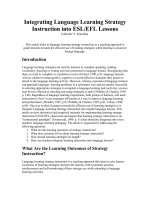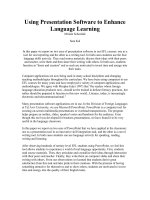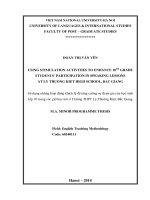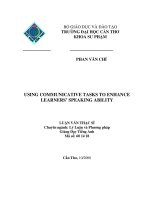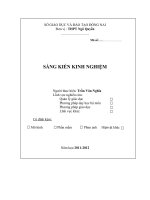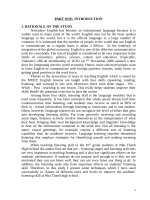Using Presentation Software to Enhance Language Learning
Bạn đang xem bản rút gọn của tài liệu. Xem và tải ngay bản đầy đủ của tài liệu tại đây (108.15 KB, 9 trang )
Using Presentation Software to Enhance
Language Learning
Miriam Schcolnik
Sara Kol
In this paper we report on two uses of presentation software in our EFL courses: one as a
tool for oral reporting and the other as a writing tool. In both cases students use the four
language skills actively. They read source materials, discuss their ideas with their peers and
teacher, write them and then share their writing with others. In both uses, students function
as "doers and creators" and as such are motivated to invest time and energy into their tasks.
Computer applications are now being used in many school disciplines and changing
teaching methodologies throughout the curriculum. We have been using computers in our
EFL courses for many years and have employed a variety of computer applications and
methodologies. We agree with Murphy-Judy (1997) that "the readers whom foreign
language education produces now...should not be trained in defunct literacy practices, but
rather should be prepared to function in this new world...Literacy, today, is increasingly
electronic and telecommunicational."
Many presentation software applications are in use. In the Division of Foreign Languages
at Tel Aviv University, we use Microsoft PowerPoint. PowerPoint is a computer tool for
creating on-screen multimedia presentations or overhead transparencies. The program helps
prepare an outline, slides, speaker's notes and handouts for the audience. Even though this
tool was developed for business presentations, we have found it to be very useful in the
language classroom.
In this paper we report on two uses of PowerPoint that we have applied in the classroom:
one as a presentation tool in an innovative skill integration task, and the other as a novel
writing tool. In both cases students can use language actively for speaking, reading, writing
and listening.
After observing hundreds of tertiary level EFL students using PowerPoint, we feel this tool
allows students to experience a world of real language opportunity. First, students read
source materials. Then, they articulate and crystallize their ideas through interaction with
their peers and teacher. Finally, they write them on computer slides and share their writing
with others. From our observations we learned that students derive great satisfaction from
this task and take pride in their creations. With the promise of having something attractive
for themselves and to show others, students are motivated to invest time and energy into
the quality of their English tasks.
Software-enhanced Oral Presentations in Language
Classes
Even though the main focus of our courses is on the comprehension of authentic academic
texts, students are required to do oral presentations. In the past, we did not specify a
uniform presentation methodology. We did recommend speaking to the audience rather
than reading from paper. Most students chose to use index cards or notes for consultation
while speaking, without visuals for the audience, while some used overhead transparencies
or other visuals along with their notes. Presentation software seemed to us a modern
alternative to previous presentation modes. We decided to require use of presentation
software for students' oral presentations, since we felt this would enhance the language
learning that takes place in the process of preparation and presentation. In this paper we
report on the use of this innovative tool. We have not attempted an empirical comparison of
the two modes.
Both in the past with oral presentations and now with computer presentations, students
were informed in advance of the criteria by which their presentations would be evaluated.
Typical criteria (relevant for both modes) include organization and coherence, synthesis
and personal contribution, quality of introduction and conclusion, reflection of
comprehension.
Language learning seems to occur most effectively when students have opportunities to use
language for real purposes. Purposeful activities help bridge the gap between the artificial
classroom setting and the real world. The process of preparing and giving oral
presentations is such a purposeful activity in that it entails finding information, reflecting
upon that information, interpreting it and creating something new. The process culminates
in the sharing of the created product with others, which serves as a springboard for
meaningful interaction.
Comparison with Purely Oral Presentations
It is not within the scope of this paper to compare use of presentation software with more
traditional presentation aids, since in the past, most of our students chose to do purely oral
presentations. After using PowerPoint with students for two years, we have found a number
of differences both in process and in product between computer presentations and purely
oral presentations. In the first place, there is a very important motivational factor when
using presentation software. Students can choose the background and foreground colors,
texture, design, layout, font and graphics for each slide thereby personalizing their
presentations. The lengthy involvement in the integration of content and form adds value to
the experiential language learning process. These observations are consistent with the
results reported by Phinney (1996) on a study that she and Khouri conducted in 1992. In
this study, students were given a choice of doing an electronic final paper or a "traditional
paper." The results showed that students who did the electronic paper enjoyed it very much,
spent more time on the project than the others, and seemed to be more involved in their
product.
Secondly, when students have to write something that their audience not only hears, but
sees, they are much more committed to the quality of their work - both content and form.
The spoken word is ephemeral; the written word remains. As a result, students revise their
presentations, and it seems this revision and recycling process enhances language learning.
Thirdly, in purely oral presentations, even if the teacher gives organization guidelines,
students can easily digress and drift. Because of the limited writing area in each slide,
students have to condense the information and limit their lists to salient points. When
giving the presentation they expand on them orally. In addition, the screen by screen
progression in a slide show induces students to impose organization on their presentations.
In the fourth place, there is a clear difference between the preparation of a purely oral
presentation and the production of computer slides. The computer presentation, in which
students may include graphics, sound, and even video in addition to textual material is
something tangible, a true production of their own.
Finally, students using the computer for their presentations say that it gives them a new
way of communicating ideas and expressing themselves. We have observed that students
produce in accordance with their learning preferences. For example, some students make
very minimal computer presentations and expand on them considerably in their talks. Other
students spend a great deal of time and effort decorating their slides and speak less. The
flexibility of the medium of presentation allows different types of learners to express
themselves in ways they feel comfortable with.
An additional difference is related to the class as an audience. Due to the fact that the
listeners can more easily follow their peers' presentations and react to them, there is a better
utilization of classroom time.
Activation of all Four Language Skills
In today's global village, listening, speaking and writing skills in English are essential for
communication. As a result, even though our courses focus on reading, we consciously
introduce tasks that activate all four language skills. "The fact that the learner will
eventually use the knowledge gained only for reading is largely irrelevant. What is of most
concern is how the learner can learn that knowledge most effectively. If the effectiveness
of the process can be enriched by the use of other skills, then that is what should be done."
(Hutchinson & Waters, 1987) The use of presentation software in a friendly, non-
threatening classroom atmosphere encourages use of all four language skills.
• Reading - In our courses, students first read a number of academic articles on a
topic of their choice, knowing that they will have to present their conclusions in
class. They analyze the articles critically, compare and contrast the ideas presented,
synthesize and evaluate. Finally, they select highlights for inclusion in their
presentations. This process is comparable to the process students go through when
reading in order to write a paper. In both cases, reading for the purpose of
transmitting information requires clarification of ideas and expression of those
ideas in such a way that others will understand.
• Writing - When composing slides, students have to condense the information they
have gathered so as to present only the main points. In this type of 'minimalistic'
writing, key concepts and words have to be retained, while the 'chaff' is discarded.
This information reduction process is in itself a difficult but very profitable
language task. While writing a minimal list of points on the screen, students can
organize a suitable sequence for the points and divide the points into slides. At the
same time, students need to take into consideration slide layout. A slide cannot be
too cluttered, the size of the font has to be large enough, and the location of the
elements on the screen has to be balanced. All this forces students to re-read, re-
evaluate and re-write what they have written again and again.
Writing for presenting differs from writing a paper. From our observation,
commitment seems to be greater when the final product is to be shown on a large
screen and read by a number of readers. This type of situation is similar to that
described by Murphy-Judy (1997) when referring to web-chats in which proper
usage and spelling are all the more "real" since they no longer "involve just a
finicky teacher with a red pen." In addition to commitment, task authenticity has to
be considered. Presenting with slides is probably a more authentic task than writing
a paper to be read only by the teacher, since academic writing in the real world
assumes multiple readers.
• Speaking - The material that students have read, organized and summarized now
has to be presented orally so as to convey a clear message to an audience of peers.
Just as they would in a purely oral presentation, students have to 'rehearse' the
pronunciation of difficult words, time themselves, and make sure that they have all
the English lexicon needed for their speech. The added value of computer
presentations is that the repeated revisions of their slides (to be seen by all of their
peers) give students extensive exposure to the content of their 'talk', helping them
remember what they want to say and giving them more self-confidence. Many
students have had no experience speaking in front of an audience in their native
language. The computer mode seems to minimize their tension and feeling of
insecurity when having to speak in English.
• Listening -The class now listens to the oral presentation. Listening to a non-native
speaker is not easy, and visual elements facilitate comprehension. We give the
listeners a task requiring them to write down three new facts that they learned about
the subject and one question to ask the speaker at the end of the presentation. When
listening for a purpose, the listening is focused and thus perhaps easier.
In a sense, we could call the student's task of preparing and giving a computer presentation
an "accordion task", as it involves extensive reading, information reduction for screen
writing, and information expansion for the purpose of presenting orally. In this use of
presentation software, the role of the computer is that of a tool. The student functions as a
researcher, developer and presenter, while the whole class functions as an audience in an
academic lecture. The teacher functions as a facilitator, teaching students how to use the
tool, guiding them in the choice of topic, providing guidelines for preparing and giving the
presentations, selecting and explaining the criteria for evaluating the presentations, guiding
students in the process of preparation, and helping them with revision. The teacher also
evaluates the presentations and gives a grade.
We believe that presentation software combined with integrated content based tasks
provide opportunities for meaningful communication in the classroom. We have observed
real involvement and language use resulting from focus on content rather than on language.
While creating esthetic presentations in English, students use the language productively
and enjoyably. In short, we have found that this process of turning input into
comprehensible output is a total language learning experience.
Students' Attitudes
At the end of the semester we administered an attitude questionnaire to find out how
students in advanced ESAP (English for Special Academic Purposes) courses felt about
working with the presentation software. Table 1 presents the results of the questionnaire.
Table 1: Results of Student Attitude Questionnaire (N = 67)
%Agree %Disagree Questionnaire item
------ --------- ------------------
84 16 helped me organize my presentation
80 20 allowed me to easily change and revise my work
79 21 helped me focus on main points
78 22 helped me create something of my own
70 30 was a challenge
70 30 gave me a new way of communicating ideas
69 31 will be useful to me in the future
68 32 was fun
68 32 made it easy to integrate ideas from different sources
65 35 was worth the time and effort
64 36 helped me understand my classmates' presentations
61 39 helped me make connections between ideas
58 42 was motivating
52 48 helped me improve my English
The results showed that most students felt the use of the presentation software was
worthwhile. A large majority felt that it helped them organize the information and focus on
main points, skills that are particularly important when reading and presenting in a foreign
language. The lower agreement to "helped me improve my English" may reflect the more
general feeling among students in ESAP courses that focus on content does not necessarily
improve their language skills.
At the end of the questionnaire, there was room left for comments. Not all students wrote
comments, but from those that did, we learned that some preferred this presentation project
to a written assignment. Others said that preparing a presentation was fun and interesting
and were glad to have learned a new tool. One student even said that the lesson where she
learned how to use the software was the most enjoyable English lesson she had ever had.
